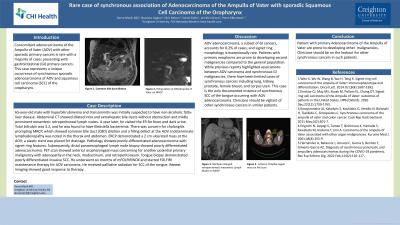Tuesday Poster Session
Category: Biliary/Pancreas
P2896 - Rare Case of Synchronous Association of Adenocarcinoma of the Ampulla of Vater With Sporadic Squamous Cell Carcinoma of the Oropharynx
Tuesday, October 24, 2023
10:30 AM - 4:00 PM PT
Location: Exhibit Hall

Has Audio
- DM
Durva Masih, MD
Creighton University
Omaha, Nebraska
Presenting Author(s)
Durva Masih, MD1, Noureen Asghar, MD1, Nicholas Nelson, DO1, Jennifer Green, MD2, Peter Silberstein, MD3, Suhail Sidhu, BS4
1Creighton University, Omaha, NE; 2Veterans Affairs Nebraska-Western Iowa Health Care, Omaha, NE; 3Creighton University and Veterans Affairs Nebraska-Western Iowa Health Care, Omaha, NE; 4Creighton University School of Medicine, Omaha, NE
Introduction: Concomitant adenocarcinoma of the Ampulla of Vater (AOV) with other sporadic primary cancers is rare with a majority of cases presenting with gastrointestinal (GI) primary cancers. This case represents a unique occurrence of synchronous sporadic adenocarcinoma of AOV and squamous cell carcinoma (SCC) of the oropharynx.
Case Description/Methods: 65-year-old male with hyperbilirubinemia and transaminitis was initially suspected to have non-alcoholic fatty-liver disease. Abdominal CT showed dilated intra and extrahepatic bile ducts without obstruction and mildly prominent mesenteric retroperitoneal lymph nodes. A year later, he visited the ER for fever and dark urine. Total bilirubin was 3.2, and he was found to have Klebsiella bacteremia. There was concern for cholangitis prompting MRCP, which showed common bile duct (CBD) dilation and a filling defect at the AOV. Indeterminate lymphadenopathy was noted in the thorax and abdomen. ERCP demonstrated a 2 cm ulcerated mass at the AOV; a plastic stent was placed for drainage. Pathology showed poorly differentiated adenocarcinoma with signet ring features. Subsequently, distal paraoesophageal lymph node biopsy showed poorly differentiated adenocarcinoma. PET scan showed anterior oropharyngeal mass concerning for another potential primary malignancy with adenopathy in the neck, mediastinum, and retroperitoneum. Tongue biopsy demonstrated poorly differentiated invasive SCC. He underwent six months of mFOLFIRINOX and started FOLFIRI maintenance therapy for AOV carcinoma. He received palliative radiation for SCC of the tongue. Repeat imaging showed good response to therapy.
Discussion: AOV adenocarcinoma, a subset of GI cancers, accounts for 0.2% of cases, and signet ring morphology is exceptionally rare. Patients with primary neoplasms are prone to developing second malignancies compared to the general population. While previous reports highlighted associations between AOV carcinoma and synchronous GI malignancies, there have been limited cases of synchronous cancers including lung, kidney, prostate, female breast, and corpus uteri. This case is the only documented instance of synchronous SCC of the tongue occurring with AOV adenocarcinoma. Clinicians should be vigilant of other synchronous cancers in similar patients.
Disclosures:
Durva Masih, MD1, Noureen Asghar, MD1, Nicholas Nelson, DO1, Jennifer Green, MD2, Peter Silberstein, MD3, Suhail Sidhu, BS4. P2896 - Rare Case of Synchronous Association of Adenocarcinoma of the Ampulla of Vater With Sporadic Squamous Cell Carcinoma of the Oropharynx, ACG 2023 Annual Scientific Meeting Abstracts. Vancouver, BC, Canada: American College of Gastroenterology.
1Creighton University, Omaha, NE; 2Veterans Affairs Nebraska-Western Iowa Health Care, Omaha, NE; 3Creighton University and Veterans Affairs Nebraska-Western Iowa Health Care, Omaha, NE; 4Creighton University School of Medicine, Omaha, NE
Introduction: Concomitant adenocarcinoma of the Ampulla of Vater (AOV) with other sporadic primary cancers is rare with a majority of cases presenting with gastrointestinal (GI) primary cancers. This case represents a unique occurrence of synchronous sporadic adenocarcinoma of AOV and squamous cell carcinoma (SCC) of the oropharynx.
Case Description/Methods: 65-year-old male with hyperbilirubinemia and transaminitis was initially suspected to have non-alcoholic fatty-liver disease. Abdominal CT showed dilated intra and extrahepatic bile ducts without obstruction and mildly prominent mesenteric retroperitoneal lymph nodes. A year later, he visited the ER for fever and dark urine. Total bilirubin was 3.2, and he was found to have Klebsiella bacteremia. There was concern for cholangitis prompting MRCP, which showed common bile duct (CBD) dilation and a filling defect at the AOV. Indeterminate lymphadenopathy was noted in the thorax and abdomen. ERCP demonstrated a 2 cm ulcerated mass at the AOV; a plastic stent was placed for drainage. Pathology showed poorly differentiated adenocarcinoma with signet ring features. Subsequently, distal paraoesophageal lymph node biopsy showed poorly differentiated adenocarcinoma. PET scan showed anterior oropharyngeal mass concerning for another potential primary malignancy with adenopathy in the neck, mediastinum, and retroperitoneum. Tongue biopsy demonstrated poorly differentiated invasive SCC. He underwent six months of mFOLFIRINOX and started FOLFIRI maintenance therapy for AOV carcinoma. He received palliative radiation for SCC of the tongue. Repeat imaging showed good response to therapy.
Discussion: AOV adenocarcinoma, a subset of GI cancers, accounts for 0.2% of cases, and signet ring morphology is exceptionally rare. Patients with primary neoplasms are prone to developing second malignancies compared to the general population. While previous reports highlighted associations between AOV carcinoma and synchronous GI malignancies, there have been limited cases of synchronous cancers including lung, kidney, prostate, female breast, and corpus uteri. This case is the only documented instance of synchronous SCC of the tongue occurring with AOV adenocarcinoma. Clinicians should be vigilant of other synchronous cancers in similar patients.
Disclosures:
Durva Masih indicated no relevant financial relationships.
Noureen Asghar indicated no relevant financial relationships.
Nicholas Nelson indicated no relevant financial relationships.
Jennifer Green indicated no relevant financial relationships.
Peter Silberstein indicated no relevant financial relationships.
Suhail Sidhu indicated no relevant financial relationships.
Durva Masih, MD1, Noureen Asghar, MD1, Nicholas Nelson, DO1, Jennifer Green, MD2, Peter Silberstein, MD3, Suhail Sidhu, BS4. P2896 - Rare Case of Synchronous Association of Adenocarcinoma of the Ampulla of Vater With Sporadic Squamous Cell Carcinoma of the Oropharynx, ACG 2023 Annual Scientific Meeting Abstracts. Vancouver, BC, Canada: American College of Gastroenterology.
